
The Royal Regiment of Artillery, commonly referred to as the Royal Artillery (RA) and colloquially known as "The Gunners", is the artillery arm of the British Army. The Royal Regiment of Artillery comprises thirteen Regular Army regiments, King's Troop Royal Horse Artillery and five Army Reserve regiments.
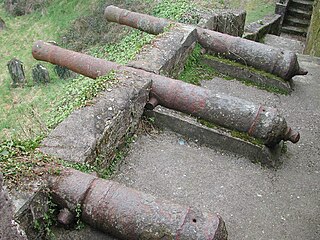
In military organizations, an artillery battery is a unit of artillery, mortars, rocket artillery, multiple rocket launchers, surface to surface missiles, ballistic missiles, cruise missiles, etc., so grouped to facilitate better battlefield communication and command and control, as well as to provide dispersion for its constituent gunnery crews and their systems. The term is also used in a naval context to describe groups of guns on warships.

The Royal Regiment of Canadian Artillery is the artillery personnel branch of the Canadian Army.

The Royal Regiment of Australian Artillery, normally referred to as the Royal Australian Artillery (RAA), is a Regiment of the Australian Army descended from the original colonial artillery units prior to Australia's federation. Australia's first guns were landed from HMS Sirius and a small earthen redoubt built, near the present day Macquarie Place, to command the approaches to Sydney Cove. The deployment of these guns represents the origins of artillery in Australia. These and subsequent defences, as well as field guns, were operated by marines and the soldiers of infantry regiments stationed in Australia. The first Royal Artillery unit arrived in Australia in 1856 and began a succession of gunner units which ended with the withdrawal of the imperial forces in 1870 resulting in the raising of the Victorian Artillery Corps in Melbourne in 1870 and the New South Wales Artillery in Sydney in 1871. The First World War saw the raising of 60 field, 20 howitzer and two siege batteries along with the heavy and medium trench mortar batteries. Until 19 September 1962 the Australian Artillery was referred to as the 'Royal Australian Artillery', however on this date HM Queen Elizabeth II granted the RAA the title of 'The Royal Regiment of Australian Artillery'. The Regiment today consists of Regular and Reserve units.
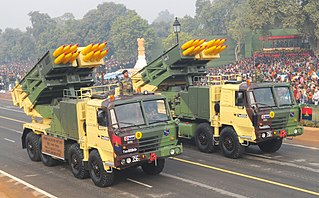
Pinaka is a multiple rocket launcher produced in India and developed by the Defence Research and Development Organisation (DRDO) for the Indian Army. The system has a maximum range of 40 km for Mark-I and 75 km for Mark-II, and can fire a salvo of 12 HE rockets in 44 seconds. The system is mounted on a Tatra truck for mobility. Pinaka saw service during the Kargil War, where it was successful in neutralising enemy positions on the mountain tops. It has since been inducted into the Indian Army in large numbers.

The M777 howitzer is a towed 155 mm artillery piece. It succeeded the M198 howitzer in the United States Marine Corps and United States Army in 2005. The M777 is also used by the ground forces of Australia, Canada, India and Saudi Arabia. It made its combat debut in the War in Afghanistan.
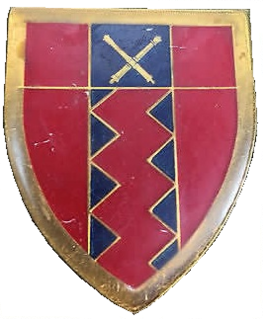
The South African Army Artillery Formation is the controlling entity of all South African Army artillery units. It draws much of its history from the South African Artillery, established in 1934 but with roots that reach back to 1921. The formation consists of both regular and reserve units. There is a separate South African Army Air Defence Artillery Formation that directs army anti-aircraft warfare units.

The Rejimen Artileri DiRaja is the artillery corps of the Malaysian Army. Rejimen Artileri DiRaja was formed in Kajang on 15 August 1957 when a single battery was formed, drawn from Malay personnel formerly serving with the British Army's Royal Regiment of Artillery. Today Rejimen Artileri DiRaja is a modern fighting arm providing direct fire support to Malaysian Army units using field artillery pieces and MLRS.
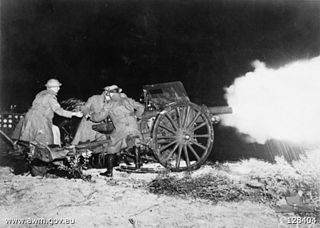
The 1st Regiment, Royal Australian Artillery is a close support regiment attached to the 7th Brigade at Enoggera Barracks in Queensland. The unit was formed in 1914 under the name 1st Australian Field Artillery Brigade, part of 1st Division Artillery during World War I and later served in World War II and the Vietnam War. It is currently re-equipping with M777A2 lightweight towed howitzers.

Counter rocket, artillery, and mortar, abbreviated C-RAM or counter-RAM, is a set of systems used to detect and/or destroy incoming rockets, artillery, and mortar rounds in the air before they hit their ground targets, or simply provide early warning.
39 Regiment Royal Artillery was part of the Royal Artillery. Its name is pronounced "three nine", The Regiment was one of the Depth fire units of 1st Artillery Brigade, part of the British Army. It was formed in 1947, and placed into suspended animation on 20 February 2015. The Regiment was based at Albemarle Barracks in Northumberland.
32 Regiment Royal Artillery is a Regiment in the Royal Artillery, part of the British Army and is equipped with the Lockheed Martin Desert Hawk III and PUMA 2 mini unmanned aerial vehicle (MUAS). 32nd Regiment is the only Royal Artillery unit that operates MUAS and along with 5th Regiment RA they provide an integrated tactical and strategic intelligence, surveillance, target acquisition, and reconnaissance (ISTAR) capability. As part of 6th Division, under the immediate command of 1st Intelligence & Surveillance Brigade (1ISR). 32nd Regiment supports the Reactive Force elements of the British Army. It provides dedicated MUAS capability to the 3rd Division, operating from the Bulldog armoured vehicle and Coyote vehicle.
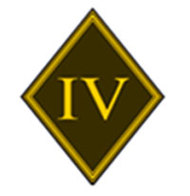
The 4th Regiment Royal Artillery is a regiment of the Royal Artillery in the British Army. It was formed in 1939 as 4th Regiment Royal Horse Artillery before being redesignated in 1961. It is currently based at Alanbrooke Barracks in Topcliffe and serves in the light field artillery role, equipped with 105mm light guns. The regiment's tactical groups can direct air, rocket, and artillery support from other formations, services, or allies.
3rd Regiment Royal Horse Artillery is a regiment of the Royal Horse Artillery in the British Army. They are currently based at Albemarle Barracks, Northumberland, England.

5th Regiment Royal Artillery is a regiment of the Royal Artillery in the British Army. It was formed in 1939 as 5th Regiment Royal Horse Artillery before being redesignated in 1958. It currently serves in the Surveillance and Target Acquisition role and is equipped with radars and acoustic sound ranging equipment; it also provides Special Observation Post teams.
The 8th/12th Regiment, Royal Australian Artillery, was formed at the Holsworthy Barracks on 16 November 1973 through the amalgamation of the 8th Medium Regiment (RAA) and the 12th Field Regiment (RAA). The Regiment provides field artillery support to the 1st Brigade based in Darwin. It is currently equipped with 155mm M777 Howitzers.
The 26th Jacob's Mountain Battery was an artillery unit of the British Indian Army. The battery traces its origins to Golandauze Battalion (1826). In 1843 it became the 10th Company Golandauze Battalion of Bombay Foot Artillery, and became the 26th Jacob's Mountain Battery in 1903. In 1947, it was transferred to the Pakistan Army, where it exists as the 1st Jacob's Battery (Baloch) of The First (SP) Medium Regiment Artillery.

The Corps of Army Air Defence, is an active corps of the Indian Army and a major combative formation tasked with air defences of the country from foreign threats. The AAD Corps is responsible for the protection of Indian air space from enemy aircraft and missiles, especially below 5,000 feet.
At the end of the Cold War in 1989 the Czechoslovak People's Army structure was as follows:















